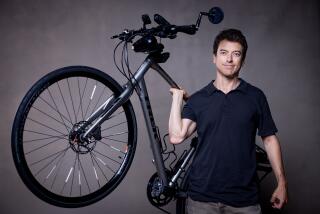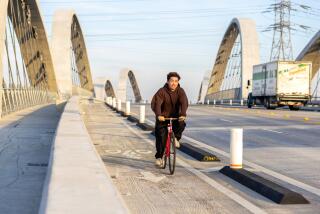CAN WE SHARE?
Mandeville Canyon Road is a two-lane, dead-end road that twists and climbs for six miles through a quiet Brentwood neighborhood. “It’s perfect for bicycling -- like honey to bears,” says Jeffrey Courion, former public policy director for Velo Club La Grange, a bicycle touring and racing club.
But with just one lane in each direction and limited visibility in some places, the road has also become a flash point for conflicts between motorists and cyclists. “It’s a problem of people competing for space,” Courion says.
That competition turned ugly in July 2008. Brentwood doctor Christopher Thomas Thompson is currently facing trial in the L.A. County Superior Court, charged with four felony counts related to a collision with two bicyclists in Mandeville Canyon. The injured cyclists allege that Thompson deliberately pulled in front of them, then slammed on his brakes, intending to hurt them. Thompson’s attorney argues that the cyclists had yelled profanities at Thompson and were to blame for the accident.
The number of people riding bicycles has exploded in recent years. U.S. census statistics released in September show a 43% increase in bike commuting nationwide between 2000 and 2008, and Courion’s bike club, which often rides in Mandeville Canyon, has seen its numbers nearly double to nearly 500 in the last several years.
This surge of new bicycles on the road frustrates some motorists, leading to antagonism and altercations of which the Mandeville Canyon incident is an extreme example. And though data suggest that cycling fatalities have actually fallen nationwide, one new study suggests that the injuries cyclists suffer in traffic accidents are becoming more severe.
The city of Los Angeles is currently updating its own bicycle infrastructure plan. Even as it does so, cycling experts and enthusiasts can’t agree on how to make the roads more bicycle-safe. Some advocate for more dedicated infrastructure, such as bike lanes. Others believe that people riding bicycles belong on the roads just as surely as do cars -- and that the key to greater safety is people cycling in a manner that reflects that right.
--
Safety in numbers
Evidence does suggest that bicycling becomes safer as more people take part. “When motorists start to expect cyclists on the roads and cycling is the norm, that helps with the accident rates,” says Tim Blumenthal, executive director of Bikes Belong, a bicycle advocacy group based in Boulder, Colo. “A lot of cities have put more bikes on the roads without a significant rise in injuries.”
Between 1998 and 2008, for example, bike commuting in Marin County increased 66% as bicycle crashes declined 34%.
Cycling enthusiasts cite numbers that suggest the benefits of cycling far outweigh the risks. According to National Highway Traffic Safety Administration statistics, the 716 bicyclist deaths in the U.S. during 2008 represented a 6% drop compared with 1998. The risk of fatality is 1 per 32 million kilometers bicycled, and the average accident rate for commuter cyclists is one accident every 8.7 years, according to Kate Scheider, research coordinator for Bikes Belong.
In a seminal and oft-cited 1992 report -- “Cycling: Towards Health and Safety” -- Mayer Hillman, a senior fellow emeritus of the Policy Studies Institute in the U.K., calculated that bicycling’s health benefits -- such as reductions in cancer, heart disease and diabetes -- outweigh its risks by a factor of 20 to 1.
But there are suggestions, too, that the types of injuries cyclists suffer have become increasingly severe. A study conducted at the Rocky Mountain Regional Trauma Center in Colorado measured a threefold increase in the number of abdominal injuries and a 15% rise in the number of chest injuries among cyclists admitted to the regional trauma center over the last 11 years.
“The number of injuries that came in to our trauma center did not increase, and mortality did not increase. What did change is the injury patterns,” says Zachary Hartman, a medical student who worked on the research. The exact reasons for the increase in injury severity remain unclear: Hartman speculates that the increased popularity of large vehicles such as SUVs could play a role. Trauma center surgeon Dr. Jeffry Kashuk, who presented the study at the Clinical Congress of the American College of Surgeons last month, puts some of the blame on Denver city planners.
He’d like to see more money spent on bike lanes and paths. “The city is promoting bicycle commuting without making the infrastructure improvements needed to make bicycles a safe form of transportation,” he says.
Still, determining the best way to make biking safer remains controversial, even among bike advocates. Some want an expanded bikeway system, with more separate bike paths and bike lanes. “The future of bicycling in the United States is not on roads that are shared by cars, but on separate facilities,” Blumenthal says. He points to cycle tracks -- a kind of bike lane separated from the roadway by a curb or other barrier--as one infrastructure improvement that could encourage more people to ride.
Other bike advocates oppose efforts to move cyclists to separate bikeways and argue instead that bicycles need to reclaim the city streets. “The bikeway system was designed for the convenience of motorists -- the safety arguments are bunkum,” says John Forester, a bicycling engineer from Lemon Grove in San Diego County.
Forester is the father of the “vehicular cycling” movement -- a philosophy that views the bicycle as a form of transportation that belongs on the streets alongside cars.
According to Forester and others in the vehicular cycling camp, efforts to push bikes into separate lanes or bike paths reinforce the notion that bicycles don’t belong on the street and relegates them to separate and not-quite-equal status. Segregating cyclists to their own paths reinforces motorist resentment toward cyclists and may encourage drivers to view cyclists on the road as scofflaws unworthy of their courtesy, Forester says.
Studies support Forester’s contention that bike lanes may make cycling more hazardous. In a study released earlier this fall, Ciaran Meyers from the University of Leeds Institute for Transport Studies in the U.K. found that motorists gave bicycles significantly more room when passing them on a road without a bike lane than they did when the cyclist was riding in a dedicated bike lane.
Bike lanes also tend to abut parking spaces, which can turn the bike lane into a door zone where an opening car door can intrude without warning into a cyclist’s path, Forester says. Such “dooring” incidents have killed cyclists in cities across the U.S.
“American bicyclists have been taught to stay to the right or get squashed, but it’s actually much safer to ride a bike as you would a car, following all the rules of the road,” Forester says.
--
Claiming the lane
Beverly Hills resident Ron Durgin, who calls himself a “bicycle lifestylist” and has not owned a car for the last 14 years, says when he first began riding, he “was of the mind set to ride in the gutter -- stay as far to the right of traffic as possible.” When Durgin rode in that manner, he found that cars came uncomfortably close as they squeezed past.
Then Durgin took a workshop on how to ride a bike in traffic and changed his entire approach. “I drive my bike as if I were driving a car, and I have very few problems now,” he says.
He says cyclists can reduce their risk of being hit from the side or run off the road if they obey all traffic laws and claim their space in the road, skills he impresses in bike safety courses he now teaches for the League of American Bicyclists.
Mutual respect is the key to safely coexisting in traffic, Blumenthal says. His group’s new slogan, “Bikes are on your side -- we’re closer than you think,” is intended to create a common identity between motorists and cyclists.
“People on bikes aren’t out to get you or slow you down,” he says. “We also drive -- and, in fact, we are you.”
The city of Los Angeles is currently taking public comments on the newly released draft of the city bicycle plan -- which updates the city’s strategy for promoting bicycling in the city via policies, programs and infrastructure improvements.
Among the recommendations in the draft are plans for nearly 400 miles of so-called Bicycle Friendly Streets, which would have signage or traffic-calming measures designed to make them better suited to bikes.
The plan also includes plans for more bike lanes, safety education and bike parking.
Senior project coordinator Michelle Mowery with the city department of transportation calls the draft a big step, but bike advocates criticize the plan for lacking the continuous north-south and east-west bikeways that bicyclists need to navigate the city.
“This plan continues the current mishmash of bike routes,” says Aurisha Smolarski, campaign director for the Los Angeles County Bicycle Coalition. “Sunset Boulevard has a bike lane, but it doesn’t connect to Hollywood. . . . Venice Boulevard has a major gap that’s missing a bike lane.”
Find out more -- or voice your comments -- at the last of five public workshops on the plan this from 6 to 8 p.m. Wednesday at Ramona Hall, 4580 N. Figueroa St., Los Angeles. View the plan at www.la bikeplan.org, or e-mail public comments to jordann.turner @lacity.org.
And read our accompanying stories for tips on what cyclists -- and motorists -- can do to make city streets safer for the people who ride on two wheels instead of four.
--
--
(BEGIN TEXT OF INFOBOX)
--
Right of way
It’s a fact: More bikes are on the road. To minimize accidents, drivers need to be aware of them and act safely. Some tips:
Give them space: Recognize that bicycles have a right to the road and may legally take the full lane. Allow at least 3 feet of space while passing.
Respect their speed: Do not underestimate how fast some cyclists are moving. In many circumstances, a bike can travel as fast as a car. Never turn in front of a bicycle, even if you think it’s traveling slowly.
When in doubt, wait: If you can’t allow the bike 3 feet of space, wait to pass until you can -- just as you would for any other slow-moving vehicle.
Be patient: Do not honk or yell at bicyclists. You could startle them or cause them to veer.
Be careful when opening your car door: When parked along roadways, look for bicyclists before opening your door, as a cyclist may be hugging the side of the road, right in the line of your car door. Open your car door into a rider’s path and you may cause a serious accident.
Look for bikes: Keep an eye out for cyclists, and always look both ways before exiting a driveway or intersection.
--
Christie Aschwanden
More to Read
Sign up for Essential California
The most important California stories and recommendations in your inbox every morning.
You may occasionally receive promotional content from the Los Angeles Times.









